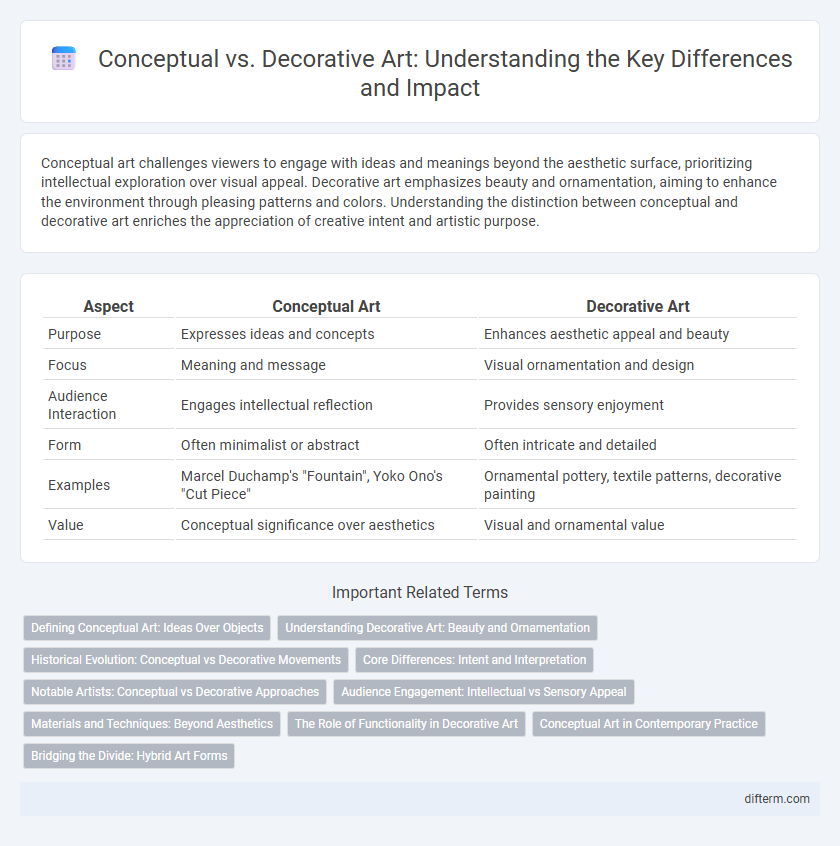Conceptual art challenges viewers to engage with ideas and meanings beyond the aesthetic surface, prioritizing intellectual exploration over visual appeal. Decorative art emphasizes beauty and ornamentation, aiming to enhance the environment through pleasing patterns and colors. Understanding the distinction between conceptual and decorative art enriches the appreciation of creative intent and artistic purpose.
Table of Comparison
| Aspect | Conceptual Art | Decorative Art |
|---|---|---|
| Purpose | Expresses ideas and concepts | Enhances aesthetic appeal and beauty |
| Focus | Meaning and message | Visual ornamentation and design |
| Audience Interaction | Engages intellectual reflection | Provides sensory enjoyment |
| Form | Often minimalist or abstract | Often intricate and detailed |
| Examples | Marcel Duchamp's "Fountain", Yoko Ono's "Cut Piece" | Ornamental pottery, textile patterns, decorative painting |
| Value | Conceptual significance over aesthetics | Visual and ornamental value |
Defining Conceptual Art: Ideas Over Objects
Conceptual art prioritizes ideas and meaning over physical aesthetics or decorative elements, challenging traditional perceptions of art as mere visual decoration. By emphasizing intellectual engagement and the artist's intent, conceptual works often use language, symbols, and documentation as primary mediums. This approach redefines art's value, shifting focus from visual appeal to the conceptual framework behind the creation.
Understanding Decorative Art: Beauty and Ornamentation
Decorative art emphasizes beauty and ornamentation, often prioritizing aesthetic appeal over conceptual depth. This art form includes functional objects like ceramics, textiles, and furniture that merge utility with intricate design. Understanding decorative art involves recognizing how visual elements enhance everyday items through patterns, colors, and craftsmanship without necessarily conveying a deeper conceptual message.
Historical Evolution: Conceptual vs Decorative Movements
The historical evolution of art reveals a clear distinction between conceptual and decorative movements, where conceptual art emerged in the 1960s as a challenge to traditional aesthetics by prioritizing ideas over visual appeal. Decorative art, rooted in ancient civilizations like Egypt and Mesopotamia, emphasizes ornamental beauty and craftsmanship, serving functional and ceremonial purposes. Movements such as Minimalism and Fluxus highlight conceptual art's shift towards intellectual engagement, contrasting with the ornamental focus of Art Nouveau and Rococo styles.
Core Differences: Intent and Interpretation
Conceptual art prioritizes ideas and meaning over visual aesthetics, emphasizing the artist's intent to provoke thought or convey complex concepts. Decorative art focuses on enhancing visual appeal and ornamentation, often intended to beautify spaces without deeper symbolic significance. Interpretation of conceptual art invites active intellectual engagement, whereas decorative art commonly offers immediate sensory enjoyment.
Notable Artists: Conceptual vs Decorative Approaches
Conceptual artists such as Sol LeWitt and Joseph Kosuth emphasize ideas and intellectual engagement over visual aesthetics, prioritizing meaning and message in their works. In contrast, decorative artists like Gustav Klimt and Henri Matisse focus on ornamental beauty, vibrant colors, and intricate patterns to enhance visual appeal. The distinction highlights the conceptual art movement's intent to challenge traditional art forms, while decorative art seeks to beautify and embellish spaces.
Audience Engagement: Intellectual vs Sensory Appeal
Conceptual art engages audiences through intellectual stimulation, prompting viewers to reflect on ideas, meanings, and social commentary. Decorative art primarily appeals to sensory appreciation by focusing on aesthetics, colors, patterns, and visual harmony within a space. The difference in audience engagement lies in the cognitive interaction for conceptual art versus the immediate sensory pleasure in decorative art.
Materials and Techniques: Beyond Aesthetics
Conceptual art prioritizes ideas and meaning, often using unconventional materials like found objects, text, and mixed media to challenge traditional artistic boundaries. Decorative art emphasizes craftsmanship and aesthetics, relying on techniques such as painting, carving, and textile weaving to enhance visual appeal and surface beauty. The choice of materials and techniques in both styles reveals their distinct purposes: conceptual art seeks to provoke thought beyond appearance, while decorative art focuses on sensory and ornamental value.
The Role of Functionality in Decorative Art
The role of functionality in decorative art bridges aesthetic appeal and practical use, enhancing everyday objects with artistic expression while maintaining usability. Decorative art often serves dual purposes, integrating design elements that enrich visual experience without sacrificing functionality. This balance distinguishes decorative art from purely conceptual art, which emphasizes ideas over practical application.
Conceptual Art in Contemporary Practice
Conceptual art in contemporary practice prioritizes the idea or concept behind the work over traditional aesthetic and decorative elements, challenging conventional perceptions of art as purely visual or ornamental. This movement emphasizes intellectual engagement and often employs diverse media, including text, performance, and installation, to provoke thought and dialogue. As a result, conceptual art redefines artistic value by foregrounding meaning and context rather than surface beauty.
Bridging the Divide: Hybrid Art Forms
Hybrid art forms seamlessly integrate conceptual depth with decorative appeal, challenging traditional boundaries between meaning and aesthetics. Artists employ mixed media and innovative techniques to create works that engage viewers both intellectually and visually. This fusion fosters a dynamic dialogue that enriches the interpretation and appreciation of contemporary art.
conceptual vs decorative Infographic

 difterm.com
difterm.com